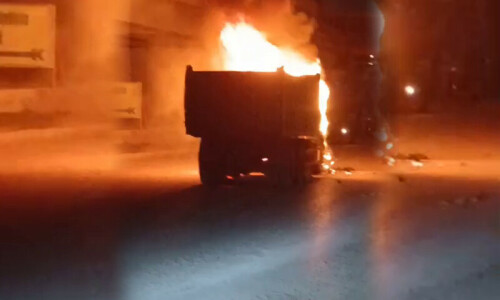Hurricane Idalia ploughed into Florida’s Big Bend region on Wednesday as an “extremely dangerous” Category 3 storm that forced millions of United States’ residents to evacuate or hunker down in anticipation of a life-threatening surge of tidal waters.
Drawing strength from the Gulf of Mexico’s warm waters, Idalia unleashed destructive winds and torrential downpours that were forecast to cause coastal flooding up to 16 feet deep along the state’s Gulf Coast.
Idalia came ashore at 7:45am EDT (1145 GMT) at Keaton Beach, an ocean-front community of 13,000 people in Taylor County about 75 miles southeast of Tallahassee, the state capital. The town lies in the centre of the Big Bend region, where the state’s northern panhandle curves into the Florida Peninsula.
“It’s just ripping through Taylor County now. Hope all is safe,” County Commissioner Jamie English told Reuters. “Winds gusting. Terrible power outages all over. Debris flying everywhere.”
There were few early reports of flooding available. By midmorning, a National Oceanic and Atmospheric Administration weather monitoring station in Steinhatchee, 20 miles south of Keaton, showed waters reaching 8 feet, well above the 6-foot flood stage. Other monitoring stations to the south in the more densely populated Tampa area showed water levels at a “minor flooding” stage at 10am EST.
All night, howling winds and seemingly endless sheets of rain pelted the house of Mark Feinman’s in-laws in St Petersburg, where he evacuated with nine other people and two cats, heeding the evacuation orders to get to higher ground.
Feinman, 37, a professional drummer and songwriter, said early on Wednesday morning that he wanted to check on his parents, who were a mile away, but that he does not plan on checking on any damage until the storm passes.
“Right now it’s calmer,” he said in a telephone interview. “We didn’t flood, so far, so hopefully we ducked the worst of it.”
Overnight, the hurricane attained “an extremely dangerous Category 4 intensity” on the five-step Saffir-Simpson wind scale, but by 7am EDT, it weakened slightly into Category 3 with maximum sustained winds of 125 miles per hour, the National Hurricane Centre (NHC) in Miami said.
By 9am EDT, maximum sustained winds had ebbed to 110 mph, the maximum strength of a Category 2 storm, the NHC said.
Early on Wednesday morning, storm winds were knocking bent palm tree tops against Ken Wood’s house in Dunedin, near Tampa and 185 miles south of landfall.
Wood, 57, a bridge tender in Pinellas County, did not heed evacuation orders even after he shut down the bridge between on the Dunedin Causeway on Tuesday, saying he figured he was on high enough ground.
“Mainly it’s a lot of loud wind and rain right now, some thunder,” he told Reuters by telephone, adding that roads were flooded. “The sky is dark.”
Danger to life
Most of Florida’s 21 million residents, and many in the adjacent states of Georgia and South Carolina, were under hurricane warnings and other storm-related advisories. State emergency declarations were issued in all three.
Florida’s Gulf Coast, southeastern Georgia and eastern parts of North and South Carolina could face four to eight inches of rain through Thursday, with isolated areas seeing as much as a foot of rain, the hurricane centre warned.
Officials said the storm’s most dangerous feature would be a powerful surge of wind-driven surf that is expected to flood low-lying areas along the coast.
Surge warnings were posted for hundreds of miles of shoreline, from Sarasota to the western end of Apalachicola Bay. In some areas, the surge could rise as high as 16 feet, the NHC said.
“If you end up with a storm surge that even approaches 16 feet, the chances of surviving that are not great,” DeSantis said. “You would need to be in a three-story building because it is going to rise very, very high.”
Government response
At the White House on Tuesday, US President Biden said he and Florida Governor Ron DeSantis, who is seeking the Republican nomination to challenge Biden in the 2024 presidential election, were “in constant contact” about storm preparations.
Biden was set to speak about the government’s hurricane response efforts later on Wednesday.
Deanne Criswell, the US Federal Emergency Management Agency’s (FEMA) administrator, said on Wednesday morning that more than 1,000 personnel from FEMA’s rapid assessment teams were ready to hit the ground to assess storm damage once Idalia passes.
Criswell also warned residents of neighbouring Georgia and South Carolina to be prepared and listen to local officials.
“Time will tell on how bad it is … and we could have more” storms, she said, adding that it has been “a very active hurricane season”.
Idalia grew from a tropical storm into a hurricane early on Tuesday, a day after passing west of Cuba, where it damaged homes, knocked out power, flooded villages and prompted mass evacuations.
It was the fourth major hurricane to strike Florida in the past seven years, following Irma in 2017, Michael in 2018 and Ian, which peaked at Category 5, last September.















































